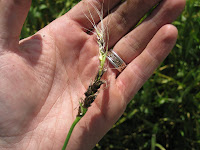
We planted 3 kinds of beans last week, the last of the crops to go in the ground. We planted roughly 4 acres of garbanzo beans, 4-5 acres of pinto beans, and 2-2.5 acres of yelloweye beans. All of the beans were planted using a 2-bottom drill we borrowed from Gathering Together Farm. One of the fields is right next to our buildings at the farm, which has 2 acres of garbanzos in it. The other beans are up the road on a field that also has hard red wheat and flax in it. We planted the beans at approximately 40-50 pounds per acre. It was somewhat hard to tell with the planter we used. We worked the ground several times to try to reduce the weed sprout. When I walked one of the fields today the weed sprout was almost nonexistent. So far, so good. Now that all the beans are in we are done planting for the spring. Here are the final tallies of crops and their acreages.
Hard Red Wheat - 122 acres
Soft White Wheat - 142 acres
Hull-less Oats - 49 acres
Cayuse Oats - 84 acres
Brown Flax - 44 acres
Sunflowers - 1 acre
Garbanzo Beans - 4 acres
Pinto Beans - 4.5 acres
Yelloweye Beans - 2.5
Annual Ryegrass - 222 acres
Tall Fescue - 77 acres
Tall Fescue (hay) - 30 acres
We should begin cutting the grass in a month or so. If this rain holds up through June it will do the beans, wheat, flax, and oats a lot of good as we got them in the ground later than we would have liked. Then we just need to pray for an indian summer!














